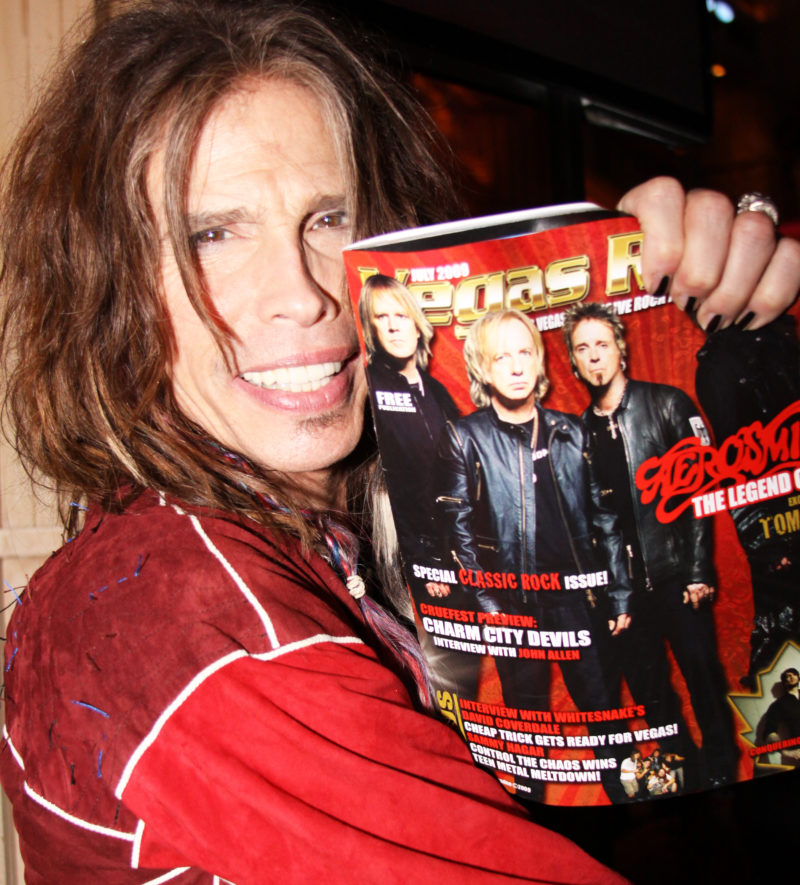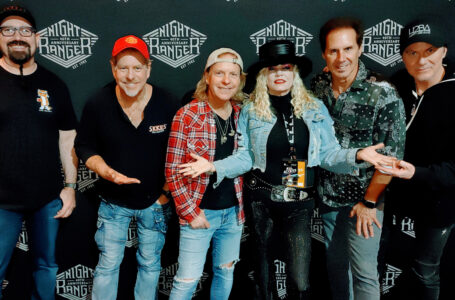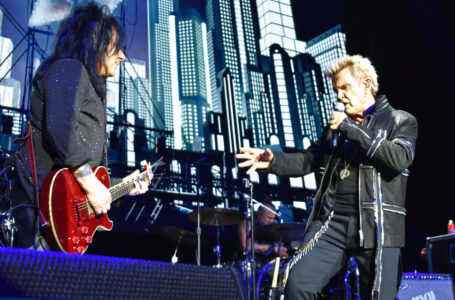Director Spike Jonze and old pals Mike D and Ad-Rock get together to tell the narrative of the hip-hop group in an Apple TV+ doc that’s really more of a filmed stage play.
The late, great monologist Spalding Gray used to sit on the stage, usually at a desk, often with a binder in front of him, and tell stories. The minimalist one-man shows weren’t inherently cinematic, but when they were adapted for the big screen, they attracted directors as dynamic as Jonathan Demme and Steven Soderbergh, drawn to the challenge of bottling the energy of a live performance — even one marked by limited movement and contained visual flourishes.
Spike Jonze’s Beastie Boys Story, premiering Friday on Apple TV+, is much more like a filmed Spalding Gray monologue than a more traditional music documentary. For nearly two hours, it’s basically Michael “Mike D” Diamond and Adam “Ad-Rock” Horovitz on the stage at Brooklyn’s Kings Theater telling the story of Beastie Boys to a wildly receptive audience, interspersed with old photographs, home movies, music videos and archival footage. An extension of the book tour from their Beastie Boys Book, it’s a duologue mixed with occasional vintage interviews with Adam “MCA” Yauch, who died of cancer in 2012.
It’s the narrative of one of the most influential bands in the history of popular music from the perspective of the core members of that band, conceived and orchestrated by a longtime friend and collaborator in Jonze. Not surprisingly, it’s a love letter, far more polished and smoothed-out than the genre-defying trio might have deserved in their anarchic heyday, but as warm and reflective as you might expect from the middle-aged men they are now.
Diamond and Horovitz have been performing together since the ’80s and they’ve been talking about the distinctiveness of Beastie Boys for nearly as long. Trading off mic time like they would in a record studio or in a concert, they trace the group back to their New York City roots, their origins in punk appreciation and their move toward hip-hop at a moment when there was real novelty to the idea of a group of white MCs.
Beastie Boys had a rise without exactly a fall: Even as they were teetering off the map in the years after 1986’s License to Ill, they were moving in the direction of the innovation that led to the artistic triumph of 1989’s Paul’s Boutique (presented here only as a commercial failure, without acknowledging its subsequent elevation to the cultural pantheon) and the even more successful remainder of their career.
Diamond and Horovitz are great storytellers. Their energy never wavers as they weave a path around the stage and even out into the audience, with Jonze’s crew prowling along with them. They contribute substantive musical anecdotes. They tell jokes. They do impressions. They get choked up when you expect them to and, if you’re a fan, it’s a near-guarantee that you’ll join them.
Somewhere in the preparation process, Beastie Boys Story became a little overrehearsed such that even the beats that should play off-the-cuff suggest repetition — like the good-natured mockery of different fashion choices or Horovitz’s ill-fated acting debut in Lost Angels. What few moments of adversity there were are quickly laughed off, whether it’s the frustration and fatigue with the U.K. leg of the License to Ill tour; good-natured suggestions that Russell Simmons cared more about their race and commercial potential than their music; or the insinuated and then dismissed hints about being screwed out of royalties by Def Jam.
Diamond, Horovitz and Jonze aren’t about ignoring the warts that a warts-and-all documentary might include, but they’re not interested in dwelling. Maybe this points to Yauch’s spiritual influence or maybe just the mellowing of age. When they speak with minor embarrassment about earlier puerile antics and the window in which anthems like “(You Gotta) Fight for Your Right (to Party!)” went from ironic commentary to a full-on bro embrace or chagrin about the misogyny of songs like “Girls,” it’s only with the tempered disappointment that comes from being 30 years beyond those missteps.
Every once in a while, something goes wrong and Jonze was smart to leave those minor blunders in the film, because the missed video cues or comically delayed sound effects are much more “Beastie Boys” than when everything is going right. Diamond and Horovitz respond to each gaffe with aplomb, and the audience laughs along eagerly, because otherwise they’re just at a play with Beastie Boys videos interspersed. And there’s absolutely nothing wrong with that. The videos are great. The photos, mostly with the charismatic Yauch front and center, generate the right mixture of nostalgic amusement and bittersweet regret.
Whatever efforts Jonze took to expand the visual elements of a stage show have been lost to our current tumultuous moment, which prevented Beastie Boys Story from getting a film festival rollout (it was initially slated for a SXSW premiere) and even an Imax theatrical release. You can sense the potential for immersion in scenes like the famous VMA performance of “Sabotage” or little cheeky gags like making Diamond and Horovitz pantomime walking in front of a back-projected tracking shot down a New York street. I don’t think suddenly splashing this across an Imax screen would have made Beastie Boys Story more of a spectacle, but it might have made the film feel less captured and contained, already its biggest drawback.
But let’s be honest: Anybody could have made a basic, talking heads-driven documentary about Beastie Boys. Jonze is a great filmmaker, and he could have made the sort of confrontational, collage-style doc that would have echoed the freewheeling, sample-driven genius of Paul’s Boutique. That is, if he’d wanted to. He gives every indication of how that documentary might have played in the final 10 minutes of Beastie Boys Story, which is a mixture of closing credits, stage show outtakes, music and imagery he couldn’t fit into the main film.
Beastie Boys Story isn’t great, but it’s quite good, and its power is in the distance between the young turks jumping around an ’80s stage and closing shows with a giant inflatable penis and the lanky, fifty-something guys looking back at those days.
-DANIEL FIENBERG






